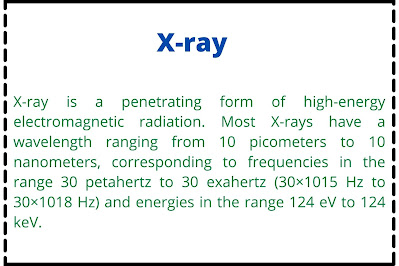Question Id: PH0000012
Question: Find the
(a) maximum frequency
(b) minimum wavelength of X-rays produced by 30 kV electrons.
Answer:
(a) Maximum frequency of the X-ray produced by 30kV electron is \(\ 7.253 \times 10^{18}Hz \).
(b) Minumum wavelength ( \(\lambda\) ) is \(0.41 \) angstroms.
Explanation:
Given, potential \(V=30kV\)
\(\Rightarrow V=30 \times 10^3V\)
\(\Rightarrow V=3 \times 10^4V\)
So, energy of the X-ray is \(E=3 \times 10^4eV\)
[ \(1eV=1.602\times 10^{-19}J\) ]
We know a particle having frequency ( \(\nu\) ) contain energy \(E=h\nu\) ; where h is Planck's constant \(h=6.626\times 10^{-34}Js\)
\[\Rightarrow \nu =\frac{E}{h}\]
\[\Rightarrow \nu =\frac{1.602\times 10^{-19} \times 3 \times 10^{4}}{6.626\times 10^{-34}}\]
\[\Rightarrow \nu =\frac{1.602 \times 3\times 10^{19} }{6.626}\]
\[\Rightarrow \nu =0.7253 \times 10^{19}\]
\[\Rightarrow \nu =7.253 \times 10^{18}\]
Hence, maximum frequency of the X-ray produced by 30kV electron is \(\ 7.253 \times 10^{18}Hz \).
(b) We know the relationship between wavelength ( \(\lambda\) ) and frequency ( \(\nu\) ) is \(c=\nu \lambda\) ; where c is velocity of light.
\[\Rightarrow \lambda =\frac{c}{\nu }\]
When frequency ( \(\nu\) )is maximum then wavelength ( \(\lambda\) ) is minimum
\[\Rightarrow \lambda_{min} =\frac{c}{\nu_{max} }\]
\[\Rightarrow \lambda_{min} =\frac{3\times 10^8}{7.253\times 10^{18} }\]
\[\Rightarrow \lambda_{min} =0.41\times 10^{-10}\]
\(\Rightarrow \lambda_{min} =0.41 \) angstroms
So, minumum wavelength ( \(\lambda\) ) is \(0.41 \) angstroms.












No comments:
Post a Comment